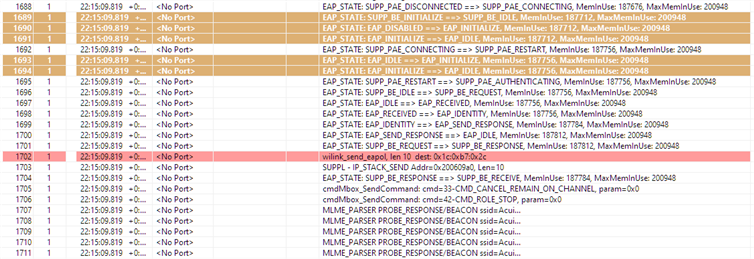Other Parts Discussed in Thread: UNIFLASH
Hi,
I haven't been able to connect to a WPA2-Enterprise network set for PEAP-MSCHAPv2..
I'm using the Network_Terminal example with the following modifications to the :cmdWlanConnectCallback() function:
1) Added code to flash the root certificate.
2) Added code to set the time.
The complete changes to the Network_Terminal examples are shown below:
//********** CA Certificate in PEM format *********************
const char TestCA[] =
"-----BEGIN CERTIFICATE-----\r\n"
"MIIDmTCCAoGgAwIBAgIQVtgg1/LEcY9N46LX/IxE2DANBgkqhkiG9w0BAQsFADBe\r\n"
"MRMwEQYKCZImiZPyLGQBGRYDY29tMRcwFQYKCZImiZPyLGQBGRYHZG9tYWluMTES\r\n"
"MBAGCgmSJomT8ixkARkWAmdsMRowGAYDVQQDExFnbC1XSU5TRVJWRVIwMS1DQTAg\r\n"
"Fw0yMTA0MDQxNzAzNTVaGA8yMDcxMDQwNDE3MTM1NVowXjETMBEGCgmSJomT8ixk\r\n"
"ARkWA2NvbTEXMBUGCgmSJomT8ixkARkWB2RvbWFpbjExEjAQBgoJkiaJk/IsZAEZ\r\n"
"FgJnbDEaMBgGA1UEAxMRZ2wtV0lOU0VSVkVSMDEtQ0EwggEiMA0GCSqGSIb3DQEB\r\n"
"AQUAA4IBDwAwggEKAoIBAQCxtTq1GWH77Bj+tarT7DV5NJV0xJLW3/T/uzxG5z4b\r\n"
"YSGddc0Wq7RRFQ6QcyCpNNeKoZ65PVetnMQl35BXRLvJLYCMhCNykSOPFtJ9K4Pq\r\n"
"QvPDWnwaw8eVl/40pB+TgNZtgKXY5iJjW6cqhXew4+feB4XMnUg0ghXiyD6ffP2g\r\n"
"F9XQ5cGoZTQd9h3JAuOfGgjyhl+m+RTjfRBPfAEVxB2lWKr0oRpf0p9B48lubjru\r\n"
"++w+cc24fPSZqD+9cRR5Y81DhgoBHNEPIdke6EQePPZOB5+He5ioHKgTDTqVP55J\r\n"
"4ezij2tjtgcpH63uCGDMAMl45fC7rfEZg/tpBj8StXTdAgMBAAGjUTBPMAsGA1Ud\r\n"
"DwQEAwIBhjAPBgNVHRMBAf8EBTADAQH/MB0GA1UdDgQWBBT0VZ4XG1CexdRJsioN\r\n"
"jh5weuelHDAQBgkrBgEEAYI3FQEEAwIBADANBgkqhkiG9w0BAQsFAAOCAQEAqR99\r\n"
"eKiZR8Vl7spiCHss3oIK9JfVJXRmcenTHDF+OcLU1BcZr67zIyoXKRNSgwmLWiGq\r\n"
"/IBfcK4Ho0DC+sAlZAwmMqDMBDDB60oJXVXZrdvOUafaiykHcr6IV6eGGGNJdFrv\r\n"
"qifRW60bgEWerwNVWjyrgf8JRzqArfv5uNDzKWoZOozXoA+YBW9hk3P3MMM/UGZ+\r\n"
"zpeBqT4/gAe2U6itpi6aVt7d4pE9znpCEZBwTIrtRPu28AALaOSaTfCa/faVBTPl\r\n"
"wBV039mAnSCk/Bq6zzfV8lCaQx0GK2vDAkxak6DgZN0DHNQpfLm+8ApogyJubvbA\r\n"
"wykJOTysAdiTLjC++w==\r\n"
"-----END CERTIFICATE-----\r\n"
;
//****** Code to flash certificate *********************
unsigned long g_tokens[4];
int16_t flashCerts(uint8_t *certName, uint8_t *buffer, uint32_t bufflen, uint32_t maxlen, bool overwriteCerts)
{
int ret = 0;
int16_t slStatus = 0;
SlFsFileInfo_t fsFileInfo;
int32_t fileHandle;
g_tokens[SL_FS_TOKEN_MASTER] = 0x12345678;
/* Check if the cert file already exists */
slStatus = sl_FsGetInfo(certName, 0, &fsFileInfo);
/* If the cert doesn't exist, write it (or overwrite if specified to) */
if (slStatus == SL_ERROR_FS_FILE_NOT_EXISTS || overwriteCerts == true)
{
fileHandle = sl_FsOpen((unsigned char *)certName,
SL_FS_CREATE | SL_FS_CREATE_SECURE | SL_FS_CREATE_VENDOR_TOKEN | SL_FS_CREATE_NOSIGNATURE
| SL_FS_CREATE_PUBLIC_READ | SL_FS_CREATE_PUBLIC_WRITE | SL_FS_OVERWRITE
| SL_FS_CREATE_MAX_SIZE(maxlen), &(g_tokens[SL_FS_TOKEN_MASTER]));
if (fileHandle > 0)
{
ret = sl_FsWrite(fileHandle, 0, (unsigned char *)buffer, bufflen);
sl_FsClose(fileHandle, NULL, NULL, 0);
}
}
return ret;
}
//******** modified cmdWlanConnectCallback ************
int32_t cmdWlanConnectCallback(void *arg)
{
int32_t ret = 0;
ConnectCmd_t ConnectParams;
/* Call the command parser */
memset(&ConnectParams, 0x0, sizeof(ConnectCmd_t));
ret = ParseConnectCmd(arg, &ConnectParams);
if(ret < 0)
{
FreeConnectCmd(&ConnectParams);
return(-1);
}
ret = flashCerts("/sys/cert/ca.der", (uint8_t *)TestCA, strlen(TestCA), 2048, 0);
/*
* Check to see if the NWP is in STA role,
* since it has to be in STA role in order to connect to an AP.
* If it isn't - set role and reset the NWP.
*/
if(app_CB.Role != ROLE_STA)
{
ret = sl_WlanSetMode(ROLE_STA);
ASSERT_AND_CLEAN_CONNECT(ret, WLAN_ERROR, &ConnectParams);
ret = sl_Stop(SL_STOP_TIMEOUT);
ASSERT_AND_CLEAN_CONNECT(ret, DEVICE_ERROR, &ConnectParams);
ret = sl_Start(0, 0, 0);
ASSERT_AND_CLEAN_CONNECT(ret, DEVICE_ERROR, &ConnectParams);
/* Here we are in STA mode */
app_CB.Role = ret;
}
/* Set static IP configurations, if needed - otherwise,
IP would be allocated by your network's DHCP server. */
if(ConnectParams.ip)
{
ret =
setStaticIPConfig((uint8_t*)(ConnectParams.ip),
(uint8_t*)(ConnectParams.gw),
(uint8_t*)(ConnectParams.dns));
ASSERT_AND_CLEAN_CONNECT(ret, CMD_ERROR, &ConnectParams);
}
/* Set device time and date before connection to ENT network, if needed */
if(ConnectParams.secParamsEnt.User != NULL)
{
ConnectParams.dateTime.tm_sec = 0;
ConnectParams.dateTime.tm_min = 0;
ConnectParams.dateTime.tm_hour = 0;
ConnectParams.dateTime.tm_day = 7; /* 1-31 */
ConnectParams.dateTime.tm_mon = 4; /* 1-12 */
ConnectParams.dateTime.tm_year = 2021; /* YYYY 4 digits */
ret =
sl_DeviceSet(SL_DEVICE_GENERAL, SL_DEVICE_GENERAL_DATE_TIME,
sizeof(SlDateTime_t),
(uint8_t *)(&ConnectParams.dateTime));
ASSERT_AND_CLEAN_CONNECT(ret, DEVICE_ERROR, &ConnectParams);
/* Connect to ENT AP */
ret =
sl_WlanConnect((const signed char *)(ConnectParams.ssid),
strlen(
(const char *)(ConnectParams.ssid)), 0,
&(ConnectParams.secParams),
&(ConnectParams.secParamsEnt));
ASSERT_AND_CLEAN_CONNECT(ret, WLAN_ERROR, &ConnectParams);
}
else
{
/* Connect to AP */
ret =
sl_WlanConnect((const signed char *)(ConnectParams.ssid),
strlen(
(const char *)(ConnectParams.ssid)), 0,
&ConnectParams.secParams, 0);
ASSERT_AND_CLEAN_CONNECT(ret, WLAN_ERROR, &ConnectParams);
}
/* Wait for connection events:
* In order to verify that connection was successful,
* we pend on two incoming events: Connected and Ip acquired.
* The semaphores below are pend by this (Main) context.
* They will be signaled once an asynchronous event
* Indicating that the NWP has connected and acquired IP address is raised.
* For further information, see this application read me file.
*/
if(!IS_CONNECTED(app_CB.Status))
{
ret = sem_wait_timeout(&app_CB.CON_CB.connectEventSyncObj,
WLAN_EVENT_TOUT);
if(ret == TIMEOUT_SEM)
{
UART_PRINT("\n\r[wlanconnect] : Timeout expired connecting to AP: %s\n\r",
ConnectParams.ssid);
FreeConnectCmd(&ConnectParams);
return(-1);
}
}
if(!IS_IP_ACQUIRED(app_CB.Status))
{
ret = sem_wait_timeout(&app_CB.CON_CB.ip4acquireEventSyncObj,
WLAN_EVENT_TOUT);
if(ret == TIMEOUT_SEM)
{
/* In next step try to get IPv6,
may be router/AP doesn't support IPv4 */
UART_PRINT(
"\n\r[wlanconnect] : Timeout expired to acquire IPv4 address.\n\r");
}
}
if(!IS_IPV6G_ACQUIRED(app_CB.Status))
{
ret = sem_wait_timeout(&app_CB.CON_CB.ip6acquireEventSyncObj,
WLAN_EVENT_TOUT);
if(ret == TIMEOUT_SEM)
{
UART_PRINT(
"\n\r[wlanconnect] : Timeout expired to acquire IPv6 address.\n\r");
}
}
if(!IS_IPV6G_ACQUIRED(app_CB.Status) &&
!IS_IPV6L_ACQUIRED(app_CB.Status) && !IS_IP_ACQUIRED(app_CB.Status))
{
UART_PRINT("\n\r[line:%d, error:%d] %s\n\r", __LINE__, -1,
"Network Error");
}
FreeConnectCmd(&ConnectParams);
return(0);
}
I have several questions:
1) Can you provide guidance as to what I could be doing wrong?
2) The swru455 documentation states that the certificate should be in PEM format but then goes on to state that the file name should be /sys/cert/ca.der. Is the .der file extension correct?
3) In order to obtain NWP logs, swru455 section 20 instruct to configure pin_62 as the UART pin. For the CC3235MODASF, pin 62 is a ground pad. Can you clarify?
Thanks.


